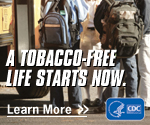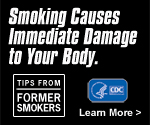Office on Smoking and Health (OSH)
Organization
OSH has a staff of about 145 people and an annual budget of approximately $100 million. Every year OSH distributes about 75 percent of these funds extramurally to support tobacco control initiatives.
OSH comprises seven major organizational units: the Office of the Director; Policy, Planning, and Coordination Unit; Resource Management Unit; Epidemiology Branch; Health Communications Branch; Program Services Branch; and Global Tobacco Control Branch.
Organizational Chart

Content of chart
Office of the Director
- Tim McAfee, M.D., M.P.H., Director
- Ronney Lindsey, M.S., Deputy Director
- Terry Pechacek, Ph.D., Associate Director for Science
- David Homa, Ph.D., Acting Deputy Associate Director for Science
- Bridgette Garrett, Ph.D.,Senior Advisor forHealth Disparities, Senior Advisors for Health Disparities
- Patty McLean, MEd, Senior Advisor for Strategic and Organization Development
- Brick Lancaster, M.A., CHES, Senior Advisor
Policy, Planning, and Coordination Unit
- Gabbi Promoff, MA., Associate Director for Policy, Planning, and Coordination
Planning Team (ATL)
- Sherrill Brady, BSN, Team Lead
Issues Management Team
- Gabbi Promoff, M.A., Team Lead
- Policy Office (D.C.)
Resource Management Unit
- Cynthia N. Johnson, Administrative Officer
Health Communications Branch
- Diane Beistle, B.A., Branch Chief
- Jane Mitchko, MEd, Acting Deputy Branch Chief
- Patti, Seikus, M.P.H., Team Lead, Information Resources
- Bob Rodes, M.S., Acting Team Lead, Research Evaluation and Technical Assistance
- Kari Sapsis, M.P.H., Team Lead, Campaign Development
Epidemiology Branch
- Ralph Carabello, Ph.D., Branch Chief
- Kevin Collins, Ph.D., Acting Deputy Branch Chief
- Ann Malarcher, Ph.D., Senior Scientific Advisor
- Marti Engstrom, M.S., Team Lead, Evaluation
- Shanta Dube, Ph.D., Team Lead, Surveillance
- Lucinda England, M.D., Team Lead, Research
- Bob Gerzoff, M.S., Team Lead, Data Analysis & Survey Support
Program Services Branch
- Karla Sneegas, MPH, Branch Chief
- Chris Benjamin, J.D., M.P.A., Deputy Branch Chief
- Monica Eischen, B.S., Team Lead, Team A
- Jerelyn Jordan, BA, Acting Team Lead, Team B
Global Tobacco Control Branch
- Samira Asma, D.D.S., M.P.H., Branch Chief
- Peter Edwards, M.P.A. (On Detail), Deputy Branch Chief
- Italia V. Rolle, Ph.D., R.D., Team Lead, School-Based Surveillance
- Vacant, Team Lead, Household-Based Surveillance
- Vacant, Team Lead, Data Coordinating Center/Information Management
Branches and Units
Office of the Director
The Office of the Director is responsible for providing broad leadership and direction for all scientific, policy, and programmatic issues related to tobacco control and use prevention.
The Associate Director for Science provides broad scientific direction to OSH programs and supervises the development of Surgeon General's reports on smoking and health.
The Office of the Director houses the following units: Policy, Planning, and Coordination Unit and the Resource Management Unit.
Policy, Planning, and Coordination Unit
The Policy, Planning, and Coordination Unit, within the Office of the Director, coordinates policy and legislative activities for OSH. The unit's functions include—
- Monitoring and analyzing legislation and policy documents.
- Conducting environmental/political scans, identifying policy options, and implementing outreach/education efforts on policy issues.
- Serving as liaison to CDC/OD and NCCDPHP/OD coordinating policy activities and responding to requests. Also serving as a liaison to OSH branches on policy issues.
- Conducting performance measurement activities, which include overseeing the development of Government Performance and Results Act (GPRA) measures and coordinating tobacco-related Healthy People objectives.
Resource Management Unit
Overview
The Resource Management Unit is responsible for managing the internal resources of OSH and the day-to-day administrative operations related to human resources, financial management, travel, procurement, facilities, and property management.
Mission, Goals, and Objectives
The Resource Management Unit, which is within the Office of the Director, coordinates support services that allow OSH to function smoothly. The unit's functions include—
- Providing office support, including processing business/supply request forms, supervising travel requests and time sheets, and assisting with personnel matters.
- Ensuring OSH's compliance with HHS, CDC, and NCCDPHP policies and procedures.
- Handling all issues related to records management, including the Freedom of Information Act and all Department of Justice matters.
- Managing OSH budget.
Health Communications Branch
Overview
The Health Communications Branch is responsible for (a) keeping the public, policy makers, health professionals, and partners informed of developments and initiatives related to tobacco control and (b) promoting positive changes regarding health behaviors, practices, and policies.
Mission, Goals, and Objectives
The Health Communications Branch serves as a primary resource for tobacco and health information. The branch develops and distributes information about tobacco and health to the public, professionals, various branches of government, and other interested groups nationwide using a wide array of formats and media channels. Communication campaigns and activities include—
- Building communities on social networking sites, such as Facebook and Twitter and offering downloadable, shareable content.
- Tracking TV and print news media coverage of tobacco-related stories.
- Designing, developing, and maintaining various tobacco-related databases.
- Providing inquiry response and referral services.
- Disseminating messages and materials in support of Surgeon General's reports.
- Developing and distributing publications.
- Providing exhibit support services.
- Managing the Smoking & Tobacco Use Web site.
- Developing and implementing a single source for credible cessation and quitline materials.
- Supporting Media Campaign Resource Center sources and activities.
- Coordinating monthly Media Network calls and monthly newsletters.
- Coordinating special communications projects.
- Providing technical assistance and support to international tobacco-control programs.
Epidemiology Branch
Overview
The Epidemiology Branch is responsible for conducting and coordinating research, surveillance, and evaluation activities related to the health effects of tobacco use. The branch provides technical assistance to states, territories, national networks, and Tribal Support Centers on surveillance and evaluation methods, including working with programs to conduct the Youth Tobacco Survey (YTS) and Adult Tobacco Survey (ATS).
Mission, Goals, and Objectives
The Epidemiology Branch mission is to advance the science base of tobacco control through a multidisciplinary program of applied research, surveillance, and evaluation. The Epidemiology Branch goal is to reduce the burden of disease through the synthesis and translation of research into practice and the dissemination of scientific findings.
Surveillance
The Epidemiology Branch assesses, improves and expands surveillance at the international, national, state, and local levels; the branch also synthesizes, translates and disseminates the results.
Research
The Epidemiology Branch assesses, improves and expands applied research on tobacco and tobacco control; the branch also synthesizes, translates and disseminates the results.
Evaluation
The Epidemiology Branch assesses, improves and expands evaluation of tobacco control programs at the international, national, state, and local levels; the branch also synthesizes, translates and disseminates the results.
Strategies
The Epidemiology Branch—
- Conducts laboratory activities and epidemiologic surveillance, research, and field investigations related to tobacco use prevention and control.
- Provides technical and scientific assistance to researchers, health departments, and other health professionals interested in performing specialized data collecting or analysis relating to smoking, other tobacco use, health effects, and program evaluation.
- Monitors trends in tobacco use prevalence as well as in the economic costs, morbidity, and mortality attributable to tobacco use.
- Conducts joint projects with federal agencies, voluntary organizations, local and state health departments, foreign ministries of health, and others involved in tobacco use prevention and control.
- Conducts economic studies on a variety of tobacco issues, including taxation and health care costs.
Program Services Branch
Overview
The Program Services Branch is responsible for (a) directing and managing the National Tobacco Control Program (NTCP) and other extramural activities to address tobacco use and (b) providing and supporting training and technical assistance to all 50 states, the District of Columbia, eight U.S. territories/jurisdictions, six national networks, and seven tribal support centers. OSH participated in CDC's grant consolidation and streamlining effort by including NTCP funding as a component of the Chronic Disease and Health Promotion program announcement. This tobacco component emphasizes policy-focused interventions and contains 11 performance measures that will help states achieve short-term, intermediate, and long-term outcomes. The program also encourages states to use key indicators to measure progress toward achieving the goals outlined in their annual action plans.
Mission, Goals, and Objectives
The mission of the Program Services Branch is to expand and enhance the implementation of effective tobacco use prevention and control interventions. The branch fulfills this mission by working with state health departments, national organizations, and national and federal partners to build capacity to support successful interventions to reduce and prevent tobacco use. The branch's responsibilities include—
- Providing technical assistance.
- Monitoring NTCP performance and progress.
- Designing and maintaining an online state progress reporting system.
- Conducting semiannual site visits to participating programs.
- Developing training programs and offering training opportunities at the national and regional levels.
- Administering, implementing, and evaluating supplemental awards activities (i.e., disparities training and quitline activities).
Global Tobacco Control Branch
Overview
Responsible for fostering global tobacco control initiatives by expanding the science base through surveillance and research, building capacity, promoting information exchange, and sharing expertise.
Mission, Goals, and Objectives
The objectives for the Global Tobacco Control Branch are to—
- Strengthen global tobacco surveillance
- Promote the dissemination and translation of data to action
- Build and maintain strategic partnerships to leverage resources for efficient and sustainable tobacco control activities
To achieve these objectives, the Global Tobacco Control Branch works through bilateral or multilateral partnerships and with health ministries and international agencies throughout the world.
Surveillance
The Global Tobacco Control Branch collaborates with the World Health Organization (WHO) and WHO regional offices on a global tobacco surveillance system (GTSS), which currently comprises three major activities: the Global Youth Tobacco Survey (GYTS), the Global School Personnel Survey (GSPS), and the Global Health Professions Student Survey (GHPSS).
The three components of GTSS uses consistent survey designs and data-processing methodologies. This consistency allows changes to be monitored over time and program effects to be measured in a standardized way across the countries, regions, and the world.
The GTSS is a successful example of monitoring tobacco use among youth and selected adult populations. The GTSS provides significant data to inform comprehensive global health promotion approaches to tobacco use prevention and control.
Research
The Global Tobacco Control Branch collaborates with other executive agencies to produce country reports, which document the national tobacco situation and control measures.
The Global Tobacco Control Branch also collaborates with partners to develop a series of published reports on products such as bidis, kreteks, and water pipes in order to address the lack of information available on novel tobacco products.
Partnerships
The Global Tobacco Control Branch partners with governments and an array of international agencies and institutions to leverage resources for mutually shared objectives to promote comprehensive tobacco prevention and control programs and policies. Partners include WHO headquarters and its regional offices—specifically, the African Region (AFR), Eastern Mediterranean Region (EMR), European Region (EUR), Region of the Americas (AMR), Southeast Asia Region (SEAR), and Western Pacific Region (WPR)—as well as the World Bank, the International Union for Health Promotion and Education, the International Union for Cancer Control, the U.S. National Cancer Institute, and the Canadian Public Health Association. CDC is also a WHO Collaborating Center on Global Tobacco Control and works with Mexico through the U.S.–Mexico Binational Commission.
File Formats: All viewers, players, and plug-ins used on this site can be downloaded from the file formats page. (For example: Adobe Acrobat Reader for pdf files, Windows Media Player for audio and video files, PowerPoint Viewer for presentation slides, etc.)
Contact Us:
- CDC/Office on Smoking and Health
4770 Buford Highway
MS K-50
Atlanta, Georgia 30341-3717 - 800-CDC-INFO
(800-232-4636)
TTY: (888) 232-6348
8am–8pm ET
Monday–Friday
Closed Holidays - tobaccoinfo@cdc.gov






